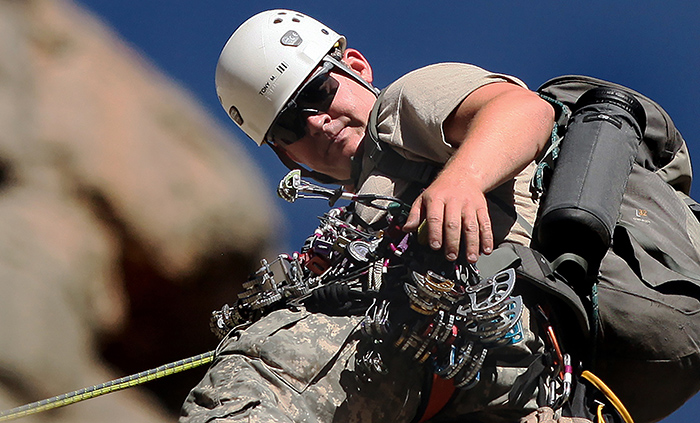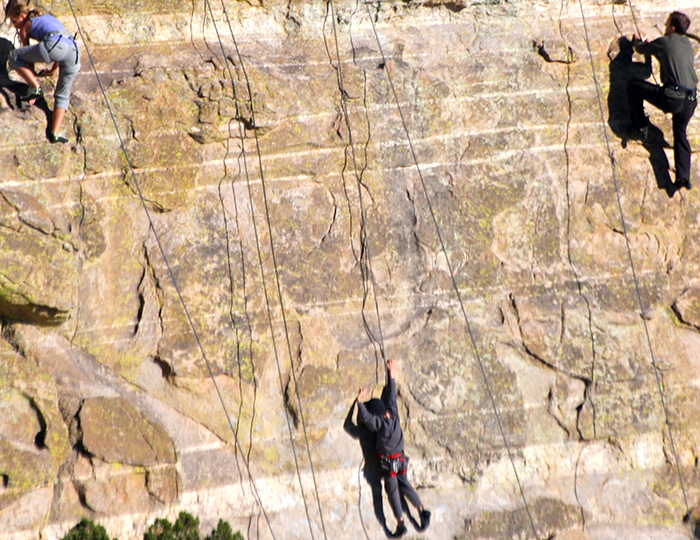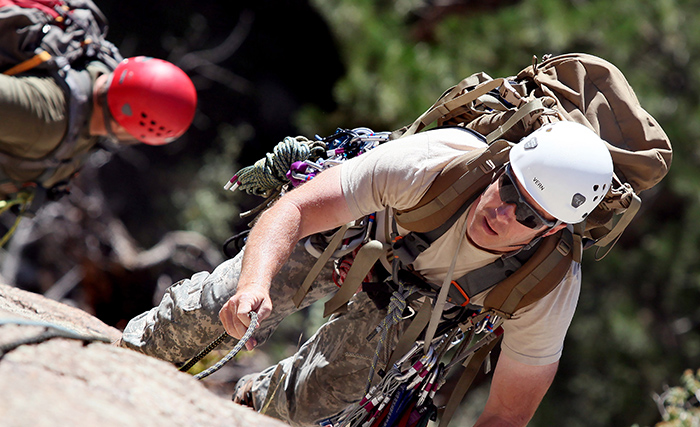Headache, Nausea, Muscle Cramping and Fatigue,all the symptoms of dehydration you might think, but these are symptoms of hyponatraemia – the over consumption of water which has previously been found to be the true cause of symptoms in as many as a quarter of contestants in prolonged exercise in hot climates who thought they were suffering from dehydration.
In sports activities where there are frequent supplies of fluid with electrolytes, you can in theory just keep topping up if the activity is well within your cardio-vascular limits. However, many activities in desert or hot climate regions often involve the circumstances of limited fluid supplies such as hiking or adventure racing where you have to carry your own fluid supply. Good hydration is not merely about carrying and consuming water, good hydration is about trying to minimise the loss of excess fluids and electrolytes from the body by maximising body temperature regulation and about replacing those lost fluids and electrolytes.
Body Temperature Regulation

At rest, the internal organs of our body-core provide warmth to our muscular-skeletal system. However when we undertake any exertion or exercise, the by-product of the energy our muscles produce is far greater heat than that produced by our body-core, this is not just the muscles on our limbs it is every piece of muscle tissue in our body. The heat generated by all of this energy is then transported by our blood away from the muscles but it is initially brought back to the body-core which at rest normally prefers to be at approximately 37oC (98.6oF). The significance of body temperature regulation is that life threatening heat stroke is an almost certain consequence of only a 3oC (5.4oF) increase in body-core temperature.
Heat exhaustion is significantly misunderstood as many believe it is the direct effect of climatic heat on the body, this is not entirely true as many suffering heat exhaustion have body-core temperatures within the normal acceptable range. The cause of the exhaustion whilst exercising in hot climates is because the cardio-vascular system is trying to undertake two conflicting tasks and hence working twice as hard. In cool climates, the cardio-vascular system is mainly focused on supplying blood rich in oxygen and nutrients to the hard working muscles. However in hot climates, the same oxygen and nutrient rich blood is being significantly targeted to the peripheral skin in a desperate attempt to shed heat from the body-core.
World record marathon holder Paula Radcliffe famously failed to finish the 2004 Athens Olympic marathon despite leading for the majority of the race and being well hydrated and with a normal body-core temperature, she probably succumbed to merely the cardio-vascular exhaustion because of having to divert so much blood to her peripheral skin to maintain a normal body-core temperature. A great topic for debate is whether, had she been wearing clothing more appropriate for extremely hot conditions would she have been able to finish the race and win gold?

It must not be underestimated that whilst a marathon in extreme heat may be needed to test the limits of professional athletes, lesser mortals can find their limits tested by far less strenuous forms of exercise in extreme heat.
Sweating
The body only sweats to regulate body temperature in hot climate or during exertion. It’s counter-productive to carry excesses of fluids if you are doing nothing to help your body stay cool. As your body-core temperature increases your cardiovascular system shifts more and more blood to the task of carrying heat away from your muscles and organs to the skin where increased sweating is your body’s natural attempt to cool yourself down by the cooling effect of the sweat evaporating. Imagine this as your body using sweat just as you would consider throwing water over yourself. The quicker the sweat evaporates, the more your body will need to produce sweat.
Most modern sports clothing is designed for less severe temperatures and far greater design emphasis is given to preventing heat loss by pulling sweat away from your skins surface and keeping you dry which in hot climates is working against your body’s thermo-regulation mechanism. Sports materials wick sweat away from your body and evaporate that sweat as quickly as possible so your body starts loosing greater amounts of fluid and the blood that is working so hard to take heat to your extremities is the same blood that should be replenishing your muscles and organs thus your physical exercise capability becomes impaired.
In extreme heat, plain cotton or wool is the preferred material of choice despite them not being considered technical fabrics as they evaporate fluid at a much slower rate so keeping a cooling layer of damp cloth against your body hence helps the body stay cooler as the evaporation process becomes extended and therefore less requirement to sweat. Cotton will quickly smell bad but performance wools particularly Merino wool performs brilliantly in body temperature regulation with the added advantage of not smelling. Alternating two thin wool tops from a small watertight canister proves a very efficient way to be able to regularly apply a freshly dampened base layer to your body.

Athletes will calculate their sweat rates by measuring body weight before and after exertion. However this can’t be realistically done by lay persons during exercises of prolonged duration such as hiking or adventures in extreme heat. What the hiker should be aware of is that an average sweat rate during moderate exertion such as hiking can be between 1 to 1.5 litres per hour so for an 8hr trek, your body could lose 8 to 12 litres of fluids which is an unrealistic quantity of replacement fluids to be carrying in your rucksack so those undertaking long duration exertion in extreme heat without readily available re-supply points should be giving greater consideration of how to minimise body-core temperature and maximise the cooling duration of the sweat they produce.
If you want to conserve fluids try to cover as much of your surface area as possible to keep your skin in shade and to increase the opportunity for a damp layer against your skin prolonging the cooling evaporation effect and requiring more heat loss to evaporate sweat from material such as cotton or thin wool.
Don’t pass on any opportunity to dampen clothing in the smallest of water supplies but ideally save your clean fluids for drinking. Also beware that high factor sun creams particularly waterproof or once-a-day application varieties can impede the evaporation of sweat and hence body-core cooling if they form a film of cream on top of the skin. SPF lotions most often supplied in sprayed bottles and appear to soak into the skin often provide the best benefit of sun protection whilst not impeding sweat evaporation and body-core cooling.
Fluid & Electrolyte Replacement
Exercising in hot climate whilst only drinking water is likely to leave you either dehydrated or hyponatraemic but rarely adequately hydrated as you won’t be replacing electrolytes which are as vitally important as the fluid itself. Some athletes will hyper-hydrate many hours before exercising. However this is only of use if you are also increasing electrolyte intake at the same time.
Fluid and electrolyte replenishment doesn’t need to be rocket science and fancy expensive sports drinks aren’t required. The electrolytes you need to replenish are mainly sodium, chloride, magnesium, potassium, calcium and glucose, these can be found readily in many foods. Remember that food sources that are more liquid are absorbed far easier by your body, I favour pre-hydrating the night before hiking with fluids and Arabic or Bedouin style soups, then prior to the actual activity slow burning carbohydrates such as wholemeal pasta. Mixing most fruit juices or non-diet soda drinks 50/50 with water tends to provide an isotonic solution but sodium content isn’t reliable so for simplicity adding rehydration powders to water is probably the most convenient option and extra sachets can easily be carried should you find additional water supplies, always check the sachet labels as they should give you suggested contents of the differing electrolytes.

Many nuts particularly salted like almonds or cashew nuts are packed with vital nutrients and energy and often cannot be beaten for the packed size versus benefits. Salted yogurt drinks such as Ayran or Laban is a common Middle Eastern drink renowned for its benefits in hot climates, small cartons can be carried in backpacks but it’s the best post-adventure refreshment served chilled in a cafe.
First Aid Implications of Hydration in Hot Climates
The medical and first aid implications relating to hydration in hot climates is short and simple. Preparation and planning of any exercise in hot climate should focus on prevention of getting into dehydration difficulties;
“A survival incident is not something you should walk yourself into.”
Pre-hydrating, appropriate clothing and roughly calculating the distances you can reasonably hike based on the amount of rehydration fluids you can carry are possibly the most vital aspect of your planning as well as having pre-determined timeframe or distances at which you must turn back or choose an escape route to a guaranteed source of replacement fluids.
Should you come across someone who has succumbed to the effects of the hot climate, your first priority is your own safety which includes the preservation of your own fluid supplies, the second priority is to try and implement the knowledge from above hence you would probably achieve more for the casualty by recognising that any spare fluid should be used to aid skin surface cooling by dampening clothing equally as much as allowing them a drink. If they are exhausted in the heat they might merely need shade and rest to recover, if they have heat stroke they require cooling, hydrating and most definitely an emergency evacuation.
Words By: Jon Edwards

